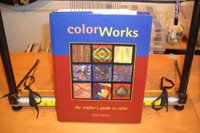I have always been intrigued by Color Theory since it discusses color in a practical manner for anyone using fiber, yarn, thread, beads, paper or other medium. Most color books focus on painting when looking at color theory. I have found you just can't mix yarn the same way you mix up paints. Some 'rules' hold true - others do not. The texture, body and content makes yarn a far more complex animal.
 The author says you should not just read the book but actually apply the concepts in your work. "You can read the book a hundred times, but without hands-on experience -actually working with color - the concepts will not become yours." How true. I have looked through this book so many times since I bought it a couple of years ago. It has the most beautiful photos. That was the reason I bought the book - - and it is an excellent reason to buy the book - if it were a bit bigger - it could be a coffee table book. It's smaller size makes it more of a studio book where it can sit nearby without taking up too much room. The book has sat on my shelf for at least a year, only to be removed now and then so I could marvel at the photos or look up a definition of a color term. I always wondered whether I would ever do anything 'real' with this book. Now is the time.
The author says you should not just read the book but actually apply the concepts in your work. "You can read the book a hundred times, but without hands-on experience -actually working with color - the concepts will not become yours." How true. I have looked through this book so many times since I bought it a couple of years ago. It has the most beautiful photos. That was the reason I bought the book - - and it is an excellent reason to buy the book - if it were a bit bigger - it could be a coffee table book. It's smaller size makes it more of a studio book where it can sit nearby without taking up too much room. The book has sat on my shelf for at least a year, only to be removed now and then so I could marvel at the photos or look up a definition of a color term. I always wondered whether I would ever do anything 'real' with this book. Now is the time.The structure of the chapters is excellent. The first section devotes two pages to the basic color relationships and terms - one page of writing and one page of photos. For example, the first term covered is hue. There are a couple paragraphs describing the concept and one describing why you would want to understand it well for your art creations. The other page is a photo of nine small samples in different mediums - handspun yarn, Fair Isle knitting, hand painted warp weaving, embroidery, beads, surface design, machine embroidery, quilting and collage. Each is done in the green hue family. I have found myself studying these for quite awhile picking up the details and nuances and better understanding the concept of 'hue' and how it can be applied to fiber. [If you want to see what it looks like go to Amazon and use the 'Search Inside' feature - there is a photo of the page of the nine green samples.]
There are two other sections that 'read' well but I have not worked through them to internalize the concepts. There is a section which discusses how to best choose colors and design. There is a section on spinning, knitting, weaving, hand embroidery, bead embroidery, surface design, machine embroidery, quilting and paper collage. Again, it is written in the one page reading - one page of photos format. For example, in the knitting section she discusses how and why she decided which colors to use in each part of the design of a Fair Isle sweater. She also describes which of the tools from the Color Tools chapter that she used to make her selection happen. All the color tools are included in the back. There are two of each tools. One to tear out, and one that stays in the book. There is even a section built into the back cover to hold the tools which are removed. I keep my grayscale there as well as my color cards. A great deal of thought went into both the content and layout of this book.
For me I am going to focus on the chapter on value. I plan to work through the concepts by making my own samples in tapestry. My first 'piece' will have at least one sample in each of the seven value keys which she describes. If you want to follow with me, I am journaling the results in our tapestry group's blog, The Weaving Divas.
Anyway, I have always liked this book - if only for the pictures. As I start into the planning and execution of this new project on value I can see I may really enjoy using the book, Color Works - the crafter's guide to color as a color theory textbook.
If you do any type of fiber work, you should own this book. You could get it out of the library - but why waste your time - just buy it. If you don't use it as a textbook atleast you will spent a lot of time marveling at the pictures.
No comments:
Post a Comment